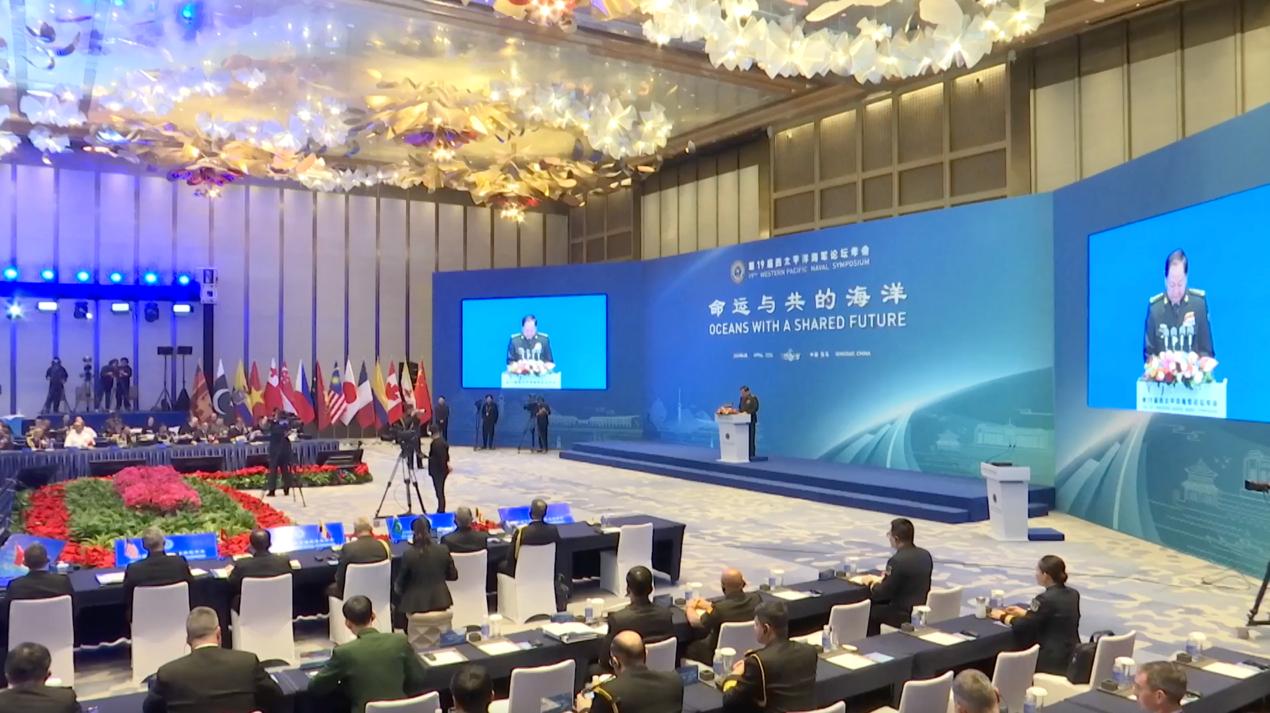Senior naval officers from around the world gathered in China on Monday for a maritime symposium aimed at seeking global governance of maritime issues.
A senior Chinese defence official reiterated China’s commitment to resolving disputes with countries directly concerned through friendly consultation, but also vowed to take “countermeasures” against unwarranted provocations.
The 19th Western Pacific Naval Symposium (WPNS) opened on Monday in the port city of Qingdao in East China’s Shandong province. Zhang Youxia, vice-chairman of the Central Military Commission, attended the event and delivered a speech, Xinhua news agency reported.
Zhang said the Chinese armed forces had actively participated in international maritime security cooperation and provided maritime public security goods, adding that China would play a more positive and open role in international military cooperation:
“We should resolutely abandon the Cold War mentality, join hands to build peace and stability, bridge differences through dialogue and consultation, jointly discuss and establish governance rules, and bring maritime security governance to a new level with practical results.”
He said China is committed to resolving maritime disputes peacefully through friendly consultations with countries directly concerned, but will safeguard its legitimate rights in the face of deliberate violations of its sovereignty and take firm countermeasures against unreasonable provocations.
Zhang said: “We will not cause trouble and will not fear trouble. China’s armed forces will resolutely safeguard national unity and interests.
Platform for talks
Held every two years and attended by naval commanders and delegates from around the world, this year’s theme is “Oceans with a Common Future” and more than 180 naval representatives from 29 countries are attending the four-day meeting.
This is the second time the WPNS has been held in China, which hosted it for the first time in 2014.
Delegates will review the symposium’s activities since its 18th biennial meeting, set the future agenda and discuss and vote on issues such as the WPNS Code of Conduct, the Code for Unplanned Encounters at Sea (CUES) and unmanned systems, Xinhua reported.
Foreign naval chiefs were invited to discuss the Global Security Initiative and maritime peace, maritime security cooperation and maritime order based on international law and global maritime governance.
Liang Wei, a senior officer at the China Naval Research Academy (NRA), said the attendance at the meeting and the number of officers from other countries attending were high. “This not only shows the vitality of the symposium, but also reflects the influence and glamour of the Chinese Navy,” Liang said, Xinhua reported.
“The symposium is a rare opportunity for countries with conflicting regional interests to exchange views,” Reuters reported on Monday. Admiral Stephen Koehler, commander of the Pacific Fleet, is attending the symposium from the United States. Other delegations include Australia, France, India, Russia and the United Kingdom.
Global Times correspondents at the symposium reported that media organisations were eager to interview US delegates, but US Navy representatives refused to answer questions.
Exercises in the South China Sea
On the same day as the opening of the WPNS, thousands of Filipino and US troops began the annual Balikatan “shoulder-to-shoulder” military exercises in the Philippines, citing “Beijing’s growing assertiveness in the region, raising fears of conflict”.
Chinese analysts said on Monday that there was no conflict in the region under former Philippine President Rodrigo Duterte, and that after the current regime took office in Manila, President Romualdez Marcos Jr. abandoned his predecessor’s “gentleman’s agreement” with China, which ensured peace and stability in the region, due to US interference. According to Chinese public opinion, the main reason for the current tensions is not China’s “growing assertiveness”, but the Philippines’ invitation to the US in the region against China.
The US-Philippine exercise is concentrated in the northern and western parts of the archipelago country, “near potential flashpoints in the South China Sea and Taiwan”.
Xu Liping, director of the Centre for Southeast Asian Studies at the Chinese Academy of Social Sciences, told the Global Times on Monday that there is no doubt that the role played by the United States in the region is destructive and harmful, and that Washington is a troublemaker and provocateur that disrupts peace and stability in the region. “US policy in the region will one day backfire, because instability is not in the interests of the United States”.
The US is using regional disputes to legitimise its military presence in the region and for Washington, the Philippines is “just a pawn on the chessboard” and if the US provokes a direct military confrontation with China, US fleets and forces can easily walk away if the situation becomes undesirable, said a Chinese military expert and WPNS participant who requested anonymity, adding that the Philippines will stay where it is and that is why no other regional country wants to be used by the US, urging Manila to realise the consequences as soon as possible.
Asked why the Philippines did not participate in the 19th WPNS, Liang, a senior Chinese military officer, told the press on Monday that “China, as a member of the WPNS, invited the other 29 member countries and observer states, and China does not know the specific reasons why the Philippine Navy did not participate in this forum”.

 OPINION2 weeks ago
OPINION2 weeks ago
 DIPLOMACY1 week ago
DIPLOMACY1 week ago
 DIPLOMACY5 days ago
DIPLOMACY5 days ago
 ASIA1 week ago
ASIA1 week ago
 DIPLOMACY7 days ago
DIPLOMACY7 days ago
 MIDDLE EAST2 weeks ago
MIDDLE EAST2 weeks ago
 MIDDLE EAST1 week ago
MIDDLE EAST1 week ago
 ASIA6 days ago
ASIA6 days ago


















